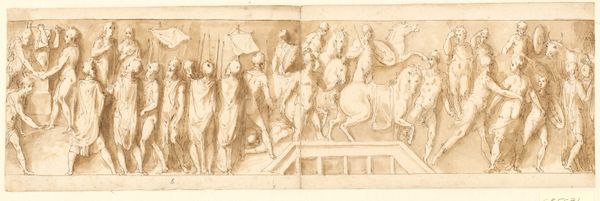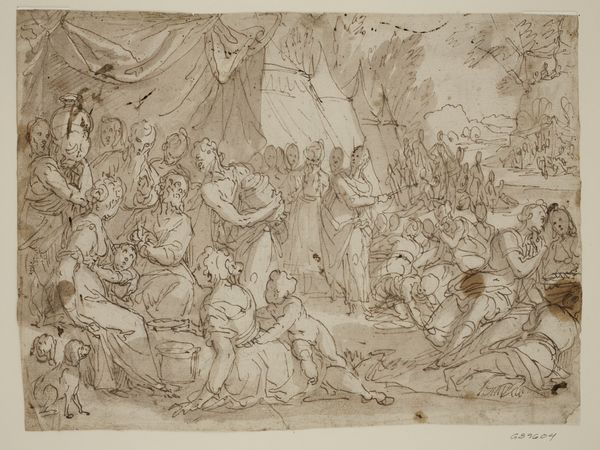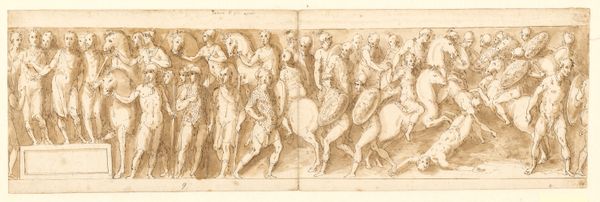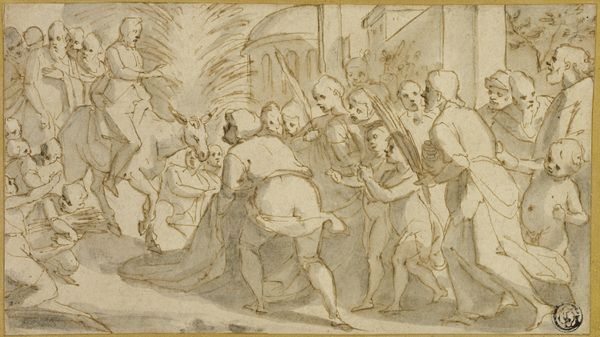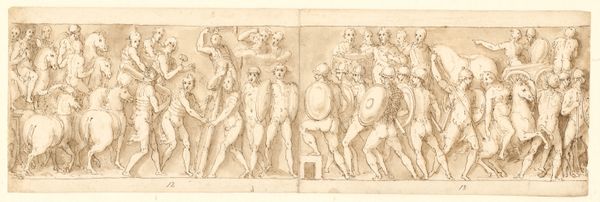
Sarmatians before the imperial council (end of LXII, beginning of LXIII); surrounded by guards, Marcus Aurelius and Pompeius on horseback watch a skirmish (XC); German nobles bringing a message (up to the middle of XCI) 1540 - 1618
0:00
0:00
drawing, paper, ink, pencil, pen
#
portrait
#
drawing
#
narrative-art
#
pencil sketch
#
classical-realism
#
charcoal drawing
#
figuration
#
paper
#
ink
#
group-portraits
#
pencil
#
pen
#
history-painting
#
academic-art
#
italian-renaissance
Dimensions: 133 mm (height) x 432 mm (width) (bladmaal)
Curator: I am struck by how this drawing encapsulates power—the almost unsettling procession. Editor: Indeed. This work, “Sarmatians before the imperial council,” dates to between 1540 and 1618 and is attributed to Giovanni Guerra. Executed in pen, ink, and pencil on paper, it presents several historical scenes related to the Roman emperor Marcus Aurelius. What I find most engaging is the density of figures—the material weight of bureaucracy visualized. Curator: Yes, the image resonates with classical authority—those horses, the shields, even the apparent submission of the Sarmatians all speak of imperial strength. Yet, there's also a haunting quality, as though witnessing a distant, immutable ritual. It brings to mind other depictions of Roman power, even those centuries later. Editor: It's crucial to remember Guerra's process here, using the fairly humble materials of pen and ink to capture a supposed history of imperial display. I’m most interested in the labor invested in producing these kinds of propagandistic drawings, each line and curve a testament to his commission. Curator: Certainly. Think about how Guerra’s decision to show specific gestures-- the lowered heads of those who present themselves-- that can function almost like an emotional shorthand, directing the viewer's reading of power and submission. We understand who holds authority. Editor: It is not just *who* holds authority, but also *how* that authority is projected. This drawing exists, undeniably, as a luxury item of visual consumption itself. Pen, ink and paper would not be a universally available selection of goods at that point, highlighting the elitism behind such images of Roman greatness. Curator: I see now what draws you to this artist's historical vision. For me, it echoes a deep vein of representation: images used again and again to build and enforce ideals about power. Editor: And, hopefully, question them! Let’s not forget the means through which these stories reach us. That’s the beauty of Guerra’s method here - exposing these assumptions about materials of power by depicting imperial themes through extremely human mediums.
Comments
No comments
Be the first to comment and join the conversation on the ultimate creative platform.




